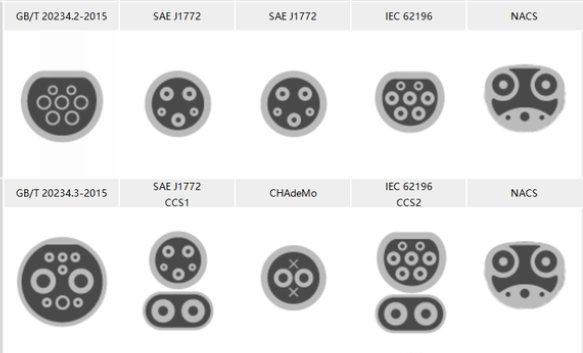New energy vehicles refer to automobiles that use non-traditional fuels or energy sources as their power source, characterized by low emissions and energy conservation. Based on different main power sources and drive methods, new energy vehicles are divided into pure electric vehicles, plug-in hybrid electric vehicles, hybrid electric vehicles, range-extended electric vehicles, and fuel cell vehicles, among which pure electric vehicles have the most booming sales.
Fuel-powered vehicles cannot function without fuel. Gas stations around the world mainly offer three grades of gasoline and two grades of diesel, which is relatively simple and universal. The charging of new energy vehicles is relatively complex. Factors such as power supply voltage, interface type, AC/DC, and historical issues in different regions have resulted in various charging interface standards for new energy vehicles worldwide.
China
On December 28, 2015, China released the national standard GB/T 20234-2015 (Connecting devices for conductive charging of electric vehicles), also known as the new national standard, to replace the old national standard from 2011. It consists of three parts: GB/T 20234.1-2015 General Requirements, GB/T 20234.2-2015 AC Charging Interface, and GB/T 20234.3-2015 DC Charging Interface.
In addition, the “Implementation Plan for the GB/T for Electric Vehicle Charging Infrastructure Interfaces” stipulates that from January 1, 2017, newly installed charging infrastructure and newly manufactured electric vehicles must comply with the new national standard. Since then, China’s new energy vehicle charging interfaces, infrastructure, and charging accessories have all been standardized.
The new national standard AC charging interface adopts a seven-hole design. The picture shows the AC charging gun head, and the corresponding holes have been labeled. CC and CP are used for charging connection confirmation and control guidance, respectively. N is the neutral wire, L is the live wire, and the center position is ground. Among them, the L live wire can use three holes. Common 220V single-phase AC charging stations generally use the L1 single hole power supply design.
China’s residential electricity mainly uses two voltage levels: 220V~50Hz single-phase electricity and 380V~50Hz three-phase electricity. 220V single-phase charging guns have rated currents of 10A/16A/32A, corresponding to power outputs of 2.2kW/3.5kW/7kW. 380V three-phase charging guns have rated currents of 16A/32A/63A, corresponding to power outputs of 11kW/21kW/40kW.
The new national standard DC ev charging pile adopts a “nine-hole” design, as shown in the picture of the DC charging gun head. The top center holes CC1 and CC2 are used for power connection confirmation; S+ and S- are communication lines between the off-board ev charger and the electric vehicle. The two largest holes, DC+ and DC-, are used for charging the battery pack and are high-current lines; A+ and A- connect to the off-board charger, providing low-voltage auxiliary power to the electric vehicle; and the center hole is for grounding.
In terms of performance, the DC charging station rated voltage is 750V/1000V, the rated current is 80A/125A/200A/250A, and the charging power can reach 480kW, replenishing half the battery of a new energy vehicle in just a few tens of minutes.
Post time: Nov-14-2025





